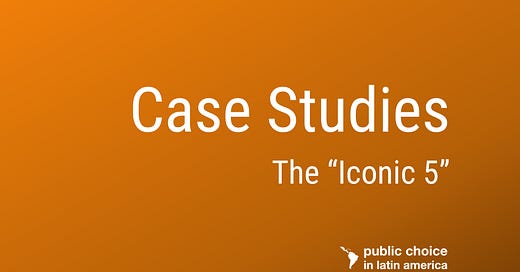In the coming weeks, we’ll be diving into what some of Latin America’s most notorious populist regimes have been up to lately. We’re focusing on what we call the “Iconic 5”:
Argentina under the Kirchners
Bolivia under Evo Morales
Ecuador under Rafael Correa
Nicaragua under Daniel Ortega
Venezuela under Hugo Chávez and Nicolás Maduro
For those familiar with the region, this lineup won’t raise eyebrows. These five countries consistently emerge as classic examples of populism in Latin America. A recent study by Funke, Schularick, and Trebesch (2023), which surveys a wide swath of populist literature, confirms this pattern.
Still, some peer reviewers have questioned our choice. So, it’s worth pointing to the Latin American Left-Leaning Populism Index (LALLPI), which further validates our focus—these five countries clearly stand out from the rest.
The “Iconic 5”
We'll be showcasing the “Iconic 5” in three different ways. The first is through a scatter plot mapping Economic Populism (PEP) against Institutional Populism (PIP). When we plot all data points, the results are striking: during their populist periods, these five countries clearly stand out from the rest.
Interestingly, the data also reveals a surprising contender—Haiti. Though often left out of the typical populist conversation, Haiti’s scores place it right between Nicaragua and Bolivia, suggesting it may well deserve a spot among the “Iconic Five.”
The second approach looks at average index values and rankings during each country’s populist regime. The table below presents this data in detail. For example, during Néstor Kirchner’s presidency (2003–2006), his average populist score was 32.54, placing Argentina at an average rank of 3.5 among all countries.
Interestingly, Cristina Kirchner is the only case where the average ranking dips just below the fifth position. This slight drop isn’t due to a lack of populism on her part—but rather because of Haiti’s unexpectedly high score, as highlighted in the scatter plot above.
Our third approach uses a time series of the Populist Index ranking to track how each country’s position evolved over time. In this case, Haiti is excluded—not only because it’s often overlooked in the populism debate, but also due to gaps in its data.
What the rankings reveal is consistent and telling: during their respective populist periods, each of the Iconic Five consistently ranks among the top five populist regimes in Latin America. This reinforces their status as emblematic cases of left-leaning populism in the region.
A Second View at the “Iconic 5”
The Latin American Left-Leaning Populism Index (LALLPI) reveals several nuances that align closely with what we know about these regimes.
First, even within the “Iconic 5,” Venezuela stands out as an extreme case. Its populist scores are significantly higher than those of the other four countries, which can sometimes create the false impression that the rest aren’t particularly populist in comparison to the broader region.
Second, the data shows that Ecuador under Rafael Correa was the regime most closely aligned with Venezuela in terms of populist intensity. As Domingo Cavallo has pointed out, Ecuador’s formal dollarization may have been what prevented it from sliding fully into the Venezuelan model.
Finally, there’s Haiti—a small, often-overlooked country that, based on its index values, could justifiably be included in the “Iconic 5.” Its absence from most discussions is likely due to its size and the relative scarcity of available data—but the numbers suggest it deserves more attention in analyses of Latin American populism.
Over the next few weeks, we’ll be diving into the Iconic 5, one country at a time—starting in alphabetical order with the Kirchners in Argentina.
If you haven’t already, make sure to subscribe so you can be among the first to receive updates from Public Choice in Latin America. You won’t want to miss it.






